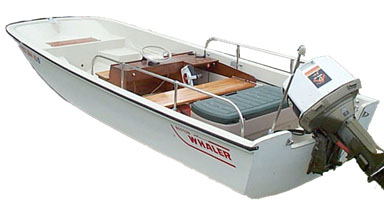
As was common for pre-Brunswick Whalers, this Currituck has OMC power on the transom.
PhotoCredit: John Flook
The Whaler 16/17-foot hull was available in over a dozen models. I've managed to collect about half of them so far...
The first step up the ladder from the bare hull was the Currituck, which featured a large side console and two thwart seats. The wooden components were made from mahogany and varnished. The console extended almost the full width of the boat and placed the wheel on the center line. Mechanical steering was standard.
 |
1973 Whaler 16 Currituck As was common for pre-Brunswick Whalers, this Currituck has OMC power on the transom. PhotoCredit: John Flook |
[TOP]
One of the earliest models available in the 16-foot hull, the Nauset (pronounced "NAW-sit") featured an elaborate mahogany center console. The 1970 Whaler catalog described it this way:
"It is on the three models of this series [Nauset, Eastport, Sakonnet] and their hybridized variations that the reputation of large Boston Whalers for total excellence has largely been built. They can negotiate in safety and reasonable comfort the wildest waters ever used for pleasure boating; yet they are adaptable to more casual types of water sport in a degree equalled by few and exceeded by none. Easy for one man to haul and launch with a trailer, they open to their owners all waterways in the country from spruce-fringed crystal lakes in the North to shallow, bone fish flats and ocean reefs in the Florida Keys-- from Massachusetts bluefish grounds in the rip tides off Martha's Vineyear to the salmon fishery and cruising paradise of the far Northwest; and besides all this they are constructed with a solid uncompromising quality normally expected only on custom-built yachts."
[ASIDE] Wow, you've got to love that language. The Whaler catalog was filled with lengthy, complex grammar like that. Compound sentences were common; semi-colons were peppered all across the catalog; lengthy dependent clauses were the norm. Now Whaler--like everyone else--tells their story in simple sentences and fragments like this: "So there's less weight, lower cost." For me, I like the old language. It really sold you the boat and the idea behind it. [OKAY, BACK TO THE BOATS]
The Nauset added lights, fixed pilot seat, console and windshield, console front seat, mechanical steering, and single lever engine controls to the base boat. In 1970 the list price was $1,995, a $695 premium over the bare hull.
 |
|
1971 Whaler 16 Nauset This particular boat was purchased originally as a 1971 bare 16-ft hull. The owner fabricated the mahogany interior, an exact copy of the Nauset. The rub rail, stainless wheel, and "Whaler" logo were updated in 1984. That little 7.5 Hp kicker is just bolted on for 1988 sea-trials as the boat was about to be sold for $5,500. The buyer got a "mint" condition Whaler. The boat looks so good in this photo that I'm ready to write a check for it! PhotoCredit: Larry Goltz |
[TOP]
The Eastport was a step up from the Nauset, designed for owners who wanted more seating. For an additional $160 (c.1970) you got a rear seat, a fire extinguisher, a compass, and seven cushions, bringing the price to $2,180.
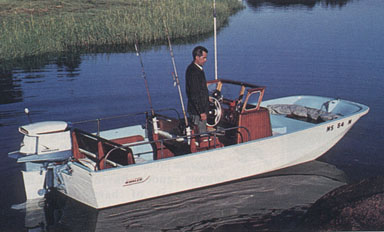 |
1961 Whaler 16 Eastport Add the rear seat and some cushions to the Nauset and it became the Eastport. A Homelite 4-stroke outboard--about 40 years ahead of its time--is on the transom. PhotoCredit: Boston Whaler Advertisement |
[TOP]
The Sakonnet (pronounced "sa-CAWN-nit") was "a luxuriously practical sport fishing vehicle" according to the catalog. For a $1070 premium over the bare hull, you got lights, reversiblepilot seat with cabinets, bow platform, console and windshield, mechanical steering, single lever engine control, stainless bow rails, bow chock, fire extinguisher, and a compass, bringing the total to $2,370 in 1970 dollars. It outlived its two sisters by a couple of years.
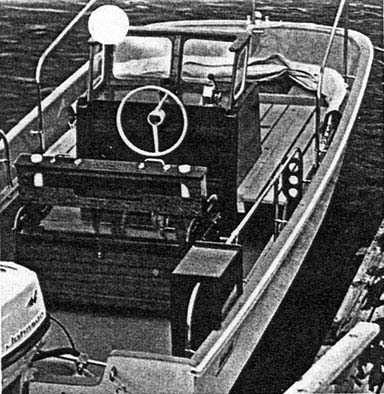 |
1971 Whaler 16 Sakonnet There is a lot of mahogany to keep varnished in this interior. The reversible pilot seat and forward platform denote the Sakonnet model. PhotoCredit: Boston Whaler Catalog |
[TOP]
The Menemsha (pronounced "meh-NEMM-sha") gave "the hardnosed outdoorsman a feeling of mastery over any possible water environment which [was] at least partly justified." For a $3700 (1970 dollars) you got the basic 16-foot hull with a unique cabin superstructure added to it. This turned what had been an open boat into a miniature cabin cruiser. For more information about the Menemsha, see the Cetacea article about it.
![[Photo: 1970 Whaler 16 Menemsha Catalogue Photo]](../../cetacea/images/menenshaCatalog470x277.jpeg) |
|
1970 Boston Whaler 16 Menemsha The Menemsha as it appeared in the catalogue. Note the stern railing which was standard on this model. PhotoCredit: Bosoton Whaler Catalogue 1970 |
[TOP]
The Tashmoo featured a wide gunwale top deck, a small center console, and a laminated rear raised deck. Some of these features were carried over into the Newport model. The Tashmoo model is nicely shown in a Cetacea article. Please see Cetacea Page 52 for details.
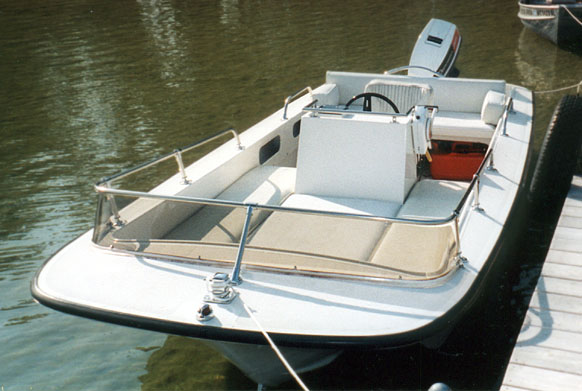 |
1971 TASHMOO A very nicely preserved example of this unusual model. |
[TOP]
The Cohasset was innovative for the center steering console. The earliest versions had a pedestal type center console, which now seems quite unusual. The Cohasset gave way to the Montauk, which has become perhaps the all-time favorite small center-console boat. The Cohasset model is nicely shown in a Cetacea article. Please see Cetacea Page 52 for details.
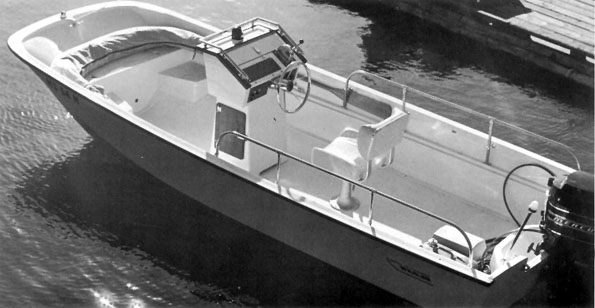 |
1972 COHASSET A very nicely preserved example of this unusual model. |
[TOP]
When the Cohasset was introduced, it marked the first production use of a molded center console in the Whaler line. (The Outrage 21 had one, too.) In 1974, the design of the center console changed and the boat became the Montauk. The MONTAUK was popular then and ever since, as it is still in production, more than 25 years later. It was the prototype of the now ubiquitous center-console fiberglass fishing boat, and it is still probably the best in its size.
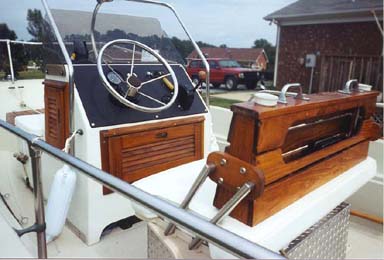 |
1979 Whaler 17 Montauk The molded center console still retained quite a bit of wood in 1979, along with other wood trim in the interior. A large metal gas tank has been added under the innovative reversible seat. PhotoCredit: Tim Heath |
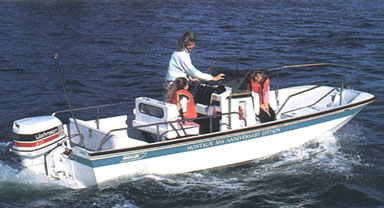 |
1991 Whaler 17 Montauk 30th Anniversary Model Missing from this replica were most of the wood hatches and trim of the original. The aqua cove stripe makes these models easy to spot. By the way, notice that it's Mom and girls out in the boat. PhotoCredit: Boston Whaler Advertisement |
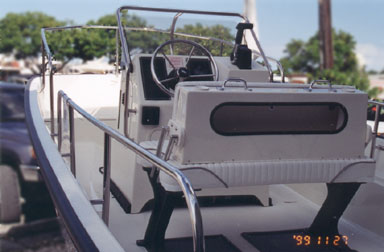 |
1999 Whaler 17 Montauk Current model of the Montauk has an all molded appearance; there's no wood to maintain. The underseat rigging appears ready for dual tanks. PhotoCredit: Larry Goltz |
[TOP]
The Newport was a model intended to please everyone, fisherman, skier, bow rider. It stayed in production for 15 years, so it must have had its fans. A side console with windscreen, mechanical wheel steering and stainless grab rail was attended by a reversible pilot seat with upholstered backrest. In the bow compartment another windshield protected passengers who rode in low, contoured bucket seats. For skiing a tow pylon was available; for fishing a rear casting platform could be added.
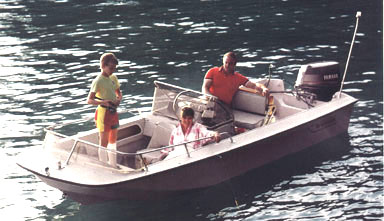 |
1988 Whaler 17 Newport This catalog photo shows the multiple purpose of the Newport; we're still fishing with our kids, but now Mom can come along and relax in a comfortable seat. Wood hatch covers and trim were still on the boat. |
[TOP]
For inland and inshore fishing, Whaler offered the Striper model, basically a molded side console and windscreen, a forward pedestal seat, and electric trolling motor.
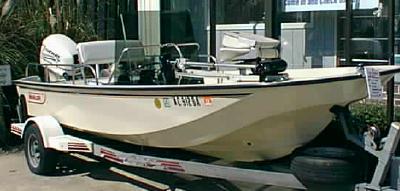 |
1984 Whaler 17 Striper Whaler's answer to the Bass Boat: The Striper, a 17-foot hull rigged for protected water fishing. PhotoCredit: Unknown |
[TOP]
Descriptions and photographs of other models will be added as they become available. If you have photographs of the interior details of any 16/17 foot Whaler, it would be greatly appreciated if you would contribute them to this article.
DISCLAIMER: This information is believed to be accurate but there is no guarantee. We do our best!
Copyright © 1999 by James W. Hebert.
This is a verified HTML 4.0 document served to you from continuousWave
URI: http://continuouswave.com
Last modified:
Author: James W. Hebert